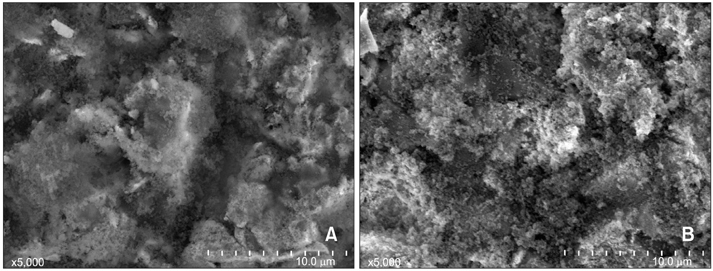Korean J Orthod.
2013 Jun;43(3):127-133. 10.4041/kjod.2013.43.3.127.
Effects of silanation time on shear bond strength between a gold alloy surface and metal bracket
- Affiliations
-
- 1Department of Orthodontics, School of Dentistry and Dental Research Institute, Seoul National University, Seoul, Korea. fortit@chol.com
- 2Department of Conservative Dentistry, School of Dentistry and Dental Research Institute, Seoul National University, Seoul, Korea.
- 3Department of Oral Anatomy, School of Dentistry and Dental Research Institute, Seoul National University, Seoul, Korea.
- KMID: 1975127
- DOI: http://doi.org/10.4041/kjod.2013.43.3.127
Abstract
OBJECTIVE
We aimed to investigate the effects of silanation time on the shear bond strength (SBS) of metal brackets on gold alloy in a silicoating procedure and compare the SBS of metal brackets on gold alloy and enamel.
METHODS
Type III gold alloy plates were sandblasted with 30-microm silicon dioxide. Excess particles were removed with gentle air after silica coating, and silane was applied. Maxillary central-incisor metal brackets were bonded to each conditioned alloy surface with a light curing resin adhesive for 1 s, 30 s, 60 s, or 120 s after applying silane. The brackets were also bonded to 36 upper central incisors with the same adhesive. All samples were cured for 40 s with a light emitting diode curing light. The SBS was tested after 1 h and after 24 h. The adhesive remnant index (ARI) of the samples was also compared.
RESULTS
The 60-s and 120-s silanation time groups showed a higher SBS than the other groups (p < 0.05). Samples tested after 24 h showed a significantly higher SBS than did the samples tested after 1 h (p < 0.05). The 1-s group showed higher ARI scores. The one-way analysis of variance and Student-Newman-Keuls test showed that the SBS values of the 60-s and 120-s silanation time groups were not significantly different from the SBS values of enamel.
CONCLUSIONS
Adequate silanation time is required to produce sufficient bond strength during silicoating.
Keyword
MeSH Terms
Figure
Cited by 1 articles
-
Effect of silica coating on bond strength between a gold alloy and metal bracket bonded with chemically cured resin
Min-Ju Ryu, Sung-Nam Gang, Sung-Hoon Lim
Korean J Orthod. 2014;44(3):105-112. doi: 10.4041/kjod.2014.44.3.105.
Reference
-
1. McLain JB, Proffitt WR. Oral health status in the United States: prevalence of malocclusion. J Dent Educ. 1985. 49:386–397.
Article2. Jung MH. Age, extraction rate and jaw surgery rate in Korean orthodontic clinics and small dental hospitals. Korean J Orthod. 2012. 42:80–86.
Article3. Boyd RL, Baumrind S. Periodontal considerations in the use of bonds or bands on molars in adolescents and adults. Angle Orthod. 1992. 62:117–126.4. Jost-Brinkmann PG, Böhme A. Shear bond strengths attained in vitro with light-cured glass ionomers vs composite adhesives in bonding ceramic brackets to metal or porcelain. J Adhes Dent. 1999. 1:243–253.5. Zachrisson BU. Orthodontic bonding to artificial tooth surfaces: clinical versus laboratory findings. Am J Orthod Dentofacial Orthop. 2000. 117:592–594.
Article6. Peutzfeldt A, Asmussen E. Silicoating: evaluation of a new method of bonding composite resin to metal. Scand J Dent Res. 1988. 96:171–176.
Article7. Jung MH. Direct bonding with composite resin; review. J Korean Found Gnatho-Orthod Res. 2005. 7:61–117.8. Ozcan M, Niedermeier W. Clinical study on the reasons for and location of failures of metal-ceramic restorations and survival of repairs. Int J Prosthodont. 2002. 15:299–302.9. Schneider W, Powers JM, Pierpont HP. Bond strength of composites to etched and silica-coated porcelain fusing alloys. Dent Mater. 1992. 8:211–215.
Article10. Toroglu MS, Yaylali S. Effects of sandblasting and silica coating on the bond strength of rebonded mechanically retentive ceramic brackets. Am J Orthod Dentofacial Orthop. 2008. 134:181e1–181e7.
Article11. Watanabe I, Kurtz KS, Kabcenell JL, Okabe T. Effect of sandblasting and silicoating on bond strength of polymer-glass composite to cast titanium. J Prosthet Dent. 1999. 82:462–467.
Article12. Shon WJ, Kim TW, Chung SH, Jung MH. The effects of primer precuring on the shear bond strength between gold alloy surfaces and metal brackets. Eur J Orthod. 2012. 34:72–76.
Article13. Nergiz I, Schmage P, Herrmann W, Ozcan M. Effect of alloy type and surface conditioning on roughness and bond strength of metal brackets. Am J Orthod Dentofacial Orthop. 2004. 125:42–50.
Article14. Jung MH, Chung SH, Shon WJ. Shear bond strength between gold alloy and orthodontic metal bracket using light emitting diode curing light. Korean J Orthod. 2010. 40:27–33.
Article15. Instructions for use [Internet]. October 22, 2012. St. Paul, MN: 3M ESPE Dental Products;Available from: http://multimedia.3m.com/mws/mediawebserver?mwsId=66666UF6EVsSyXTt4Xf6Mxf2EVtQEVs6EVs6EVs6E666666--&fn=espe_sil_ifu_we_R1.pdf.16. Instructions for use [Internet]. October 22, 2012. Itasca, IL: Reliance Orthodontic Products Inc;Available from: http://www.relianceorthodontics.com/store/files/instructions/PorcEtch_PorcelainConditioner_032609.pdf.17. Bishara SE, VonWald L, Olsen ME, Laffoon JF. Effect of time on the shear bond strength of glass ionomer and composite orthodontic adhesives. Am J Orthod Dentofacial Orthop. 1999. 116:616–620.
Article18. Büyükyilmaz T, Zachrisson YO, Zachrisson BU. Improving orthodontic bonding to gold alloy. Am J Orthod Dentofacial Orthop. 1995. 108:510–518.
Article19. Proffit WR, Fields HW, Nixon WL. Occlusal forces in normal- and long-face adults. J Dent Res. 1983. 62:566–570.
Article20. Reynolds IR. A review of direct orthodontic bonding. British J Orthod. 1975. 2:171–178.
Article21. Trakyali G, Malkondu O, Kazazoğlu E, Arun T. Effects of different silanes and acid concentrations on bond strength of brackets to porcelain surfaces. Eur J Orthod. 2009. 31:402–406.
Article22. Nebbe B, Stein E. Orthodontic brackets bonded to glazed and deglazed porcelain surfaces. Am J Orthod Dentofacial Orthop. 1996. 109:431–436.
Article
- Full Text Links
- Actions
-
Cited
- CITED
-
- Close
- Share
- Similar articles
-
- Effect of silica coating on bond strength between a gold alloy and metal bracket bonded with chemically cured resin
- Shear bond strength between gold alloy and orthodontic metal bracket using light emitting diode curing light
- Effect of metal primer and thermocycling on shear bonding strength between the orthodontic bracket and gold alloy
- Change of shear bond strength of orthodontic brackets acording to surface treatment on dental gold alloy
- THE EFFECTS OF METAL SURFACE TREATMENTS ON THE BONE STRENGTH OF POLYMETHYL METHACRYLATE BONDED REMOVABLE PROSTHESE


